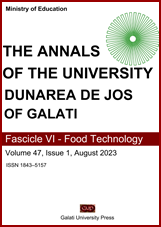In vitro antioxidant and antidiabetic activity of mace from Myristica Fragrans houtt
Abstract
This research investigated the antioxidant and antidiabetic properties of mace from nutmeg (Myristica fragrans Houtt) using in vitro experiments. The nutmeg samples, including distilled water extract (EA), methanol extract (EM), methanol fraction (FM), hexane fraction (FH), and chloroform fraction (FC), were analysed for yield, total phenolic content, antioxidant activity (using 1,1-diphenyl-2-picryl-hydrazyl radical scavenging activity-DPPH RSA and ferric reducing antioxidant power-FRAP), and α-amylase inhibitory activity. The highest yield was found in EM (25.39±0.62% db), while the highest phenolic content was achieved in FC (127.18±3.64 mg GAE/g dry fraction). In terms of antioxidant, the highest activity by DPPH assay was found in FM phenolic (IC50=2.56±0.02 mg/L) and FC phenolic (IC50=2.79±0.05 mg/L), while EA phenolic demonstrated the highest activity using FRAP assay (9.16±0.86 g TE/100 g phenolic). The EA phenolic also showed the greatest inhibition against α-amylase (IC50=360.18±6.83 mg/L). A positive correlation was found between the ability to reduce the ferric ion of mace samples and its α-amylase inhibitory activity. The results suggest that phenolic from nutmeg mace extract/fraction of obviously exerted antioxidant activity (4.9 times higher than ascorbic acid) and antidiabetic activity (4.2 times higher than acarbose). For this reason, the mace of nutmeg (Myristica fragrans Houtt) can be a considerable source of natural antioxidants and antidiabetic.


